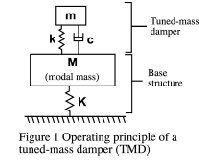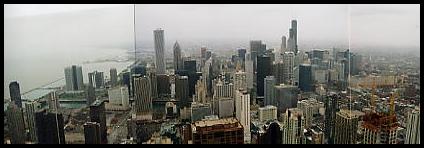This is an aerial view of Chicago's skyscrapers.
Skyscrapers are amazing! Architectural defeats. Wonders of the world. How are they able to withstand even the strongest of winds and earthquakes?
Today, engineers rely on damping systems to counteract nature's forces. There are many types of damping systems that engineers can now use for structures, automobiles, and even tennis rackets! This site focuses on damping systems in structures, mainly architectural variations of the tuned mass damper.
How Tuned Mass Dampers Work

This figure is from CSA Engineering, Inc.
A tuned mass damper (TMD) consists of a mass (m), a spring (k), and a damping device (c), which dissipates the energy created by the motion of the mass (usually in a form of heat). In this figure, M is the structure to which the damper would be attached.
From the laws of physics, we know that F = ma and a = F/m. This means that when an external force is applied to a system, such as wind pushing on a skyscraper, there has to be an accleration. Consequently, the people in the skyscraper would feel this acceleration. In order to make the occupants of the building feel more comfortable, tuned mass dampers are placed in structures where the horizontal deflections from the wind's force are felt the greatest, effectively making the building stand relatively still.
When the building begins to oscillate or sway, it sets the TMD into motion by means of the spring and, when the building is forced right, the TMD simultaneously forces it to the left.
Ideally, the frequencies and amplitudes of the TMD and the structure should nearly match so that EVERY time the wind pushes the building, the TMD creates an equal and opposite push on the building, keeping its horizontal displacement at or near zero. If their frequencies were significantly different, the TMD would create pushes that were out of sync with the pushes from the wind, and the building's motion would still be uncomfortable for the occupants. If their amplitudes were significantly different, the TMD would, for example, create pushes that were in sync with the pushes from the wind but not quite the same size and the building would still experience too much motion.
The effectiveness of a TMD is dependent on the mass ratio (of the TMD to the structure itself), the ratio of the frequency of the TMD to the frequency of the structure (which is ideally equal to one), and the damping ratio of the TMD (how well the damping device dissipates energy). For more information and a graph, click here.
